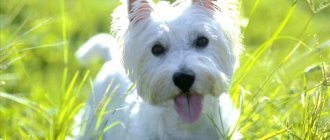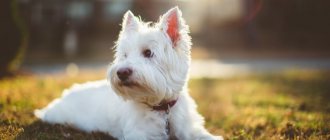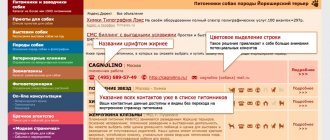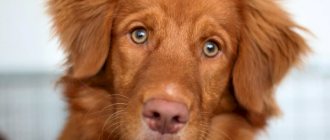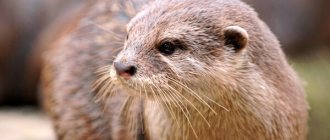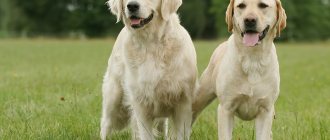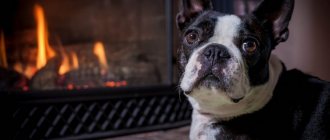The Curly-Coated Retriever, or Curly, is an elegant, high-legged dog with a strong, slightly elongated body and a thick coat of fine, tight, well-defined curls. It was bred to hunt ducks and other waterfowl, but is actively used as a search engine, guide dog and companion.
Let's find out what a curly-haired retriever is and what the specifics of keeping the breed are.
History of the Curly Coated Retriever breed
Little is known about the origins of this breed.
He may be a descendant of the extinct English Water Spaniels and Retrievers, as well as other retriever dogs, including poodles, which are essentially retrievers themselves. Whatever its descendant, the Curly Coated Retriever first appeared in the show ring in England in 1860 and is believed to have been the first dog to be used to describe the standard. After World War I, in 1919, only five Curly Coated Retrievers were registered. The breed began to recover, but again almost went extinct during World War II.
The Curly-Coated Retriever was first imported to the United States in 1907, but did not gain much popularity.
The breed saw a resurgence in the late 1960s when many curly-coated retrievers were imported from England, Australia and New Zealand. The American Curly-Coated Retriever Club was founded in 1979.
Care and maintenance
The most important thing in caring for a curly-coated retriever is to monitor the condition of its coat. The dog should be brushed with a natural bristle brush every 2-3 days. It is also important to bathe your dog regularly, but it is not recommended to use detergent every time.
Regularly examine the animal’s ears and eyes, and monitor the condition of the teeth. However, no special care is required for these organs. The Curly-Coated Retriever is an active dog and needs constant exercise. Don't forget to walk your pet every day and include a variety of games in its daily routine.
Purpose and character of the curly-coated retriever
Curly-coated retrievers, or Curlies, are used at customs to search for prohibited substances, as search dogs and rescue dogs by rescue services, and as a guide for the blind. Curley is a wonderful companion dog. The retriever is also a hunting gun dog.
The main character traits of the Curly are balance, devotion, and meaningfulness of every step. Such retrievers are devoted to the whole family; they do not single out one specific person in it. They are cold and reserved towards strangers, and can also show aggression if they sense danger.
Communication with people is a constant necessity for them. But they will not be a nanny for a small child. Curlies do not allow their ears to be pulled or their tails to be bitten. But they will not show aggression, but will simply move away. But the danger of an inadequate reaction from the dog in such cases still exists. But for a teenager this is an ideal companion dog. The dog is ready to share both work and rest with its beloved owners. The retriever treats other pets with indifference and condescension. And he finds a common language with the dogs who also live in the house.
Health and life expectancy
Alas, although in general the curly Labrador can boast of fairly good health, some diseases are inherited or can develop over time. First of all this:
- joint dysplasia;
- baldness;
- retinal dysplasia;
- epilepsy;
- volvulus;
- cancer.
But, despite this, the average life expectancy of representatives of the breed is quite good - about 9-14 years. For dogs of this size this is a very good indicator.
Such a pet will easily become the star of the exhibition
By adopting a curly-haired retriever, a dog lover will change his life forever. And, for sure, he will never regret his choice.
MALES
ALTAFLATS BUBBLE TROUBLE (2015)
BANANA SPLIT MALMESBURY OPTIMUS CANIS (2014) BERSIFIER BENFATTO IO (2014) VALNERIS DIAMOND GLOW (2010) VANDER VALLEY OLIGARCH (2012) VANDER VALLEY ORPHEUS (2012) VANDER VALLEY CHALLENGER (2010) ALWAYS NEAR AN ADVENTURIST IN LIFE ( 2012) HEDGEHOGES FROM THE CAPITAL OF THE URAL (2019) CAZADOR DE PATOS GUSKA STEPAN (2019) LUSSO ANGELO PRINCIPE ( 2012) MEISTER JP EXCELLENT PERFORMANCE (2018) JOY FROM ISTRA BAKARDI BLACKS (2009) JOY FROM ISTRA BENEDI KTIN (2009) RETLANE POLYGON (2018) NORTHERN KINGDOM AQUAMARINE (2011) STARS MARYLAND ELISHAUS (2014) STARS MARYLAND HERMOLAUS (2014) STANWAYS LEGEND (2012 TOFFEDREAM'S SNIPER (2013) FIRESTAR BLACK BRIANTA (2018) EVALIZE GEOFFREY ( 2016)
STORY OF DARK DEVOTION HIP HAWKEYE HUNTER
ALMANZA TOTALLY MIND-BLOWING BRIAREY EGEON THE MIGHTY JOY FROM ISTRA BLACK RUSSIAN (2009) JOY FROM ISTRA GOOD NEWS
Personal form factor
The Curly Curly is a calm, reasonable and absolutely non-conflict breed. Curly-haired dogs amaze with their highest intelligence, quick wit and everyday acumen: no spontaneous breakthroughs, unmotivated activity, or rash actions.
Three fundamental pillars of the breed: rationality, devotion, hard work. The expert community criticizes the breed for “mental overkill”: the dogs are “famous” for being too independent.
Orientation towards the owner, loyalty to the leader-handler are recognized talents of the breed: the Curley Retriever is selflessly devoted to the owner, gentle and courteous with household members. These curly-haired hunters willingly spend time with the children, actively participate in noisy fun, while simultaneously guarding (protecting) the younger generation of the clan. In everyday life and “peaceful” everyday life, a well-socialized and well-mannered curly-haired retriever is demonstrably peaceful, disciplined and sociable.
Curly-haired aristocrats are uniquely loyal to other domestic animals: the dogs are not dominant, but they will not allow anyone to “sit on their necks.” This is the British format of socialization: strict adherence to personal distance, accentuated by ostentatious friendliness.
Large and fast-moving dogs are very reluctant to make contact with strangers: clan isolation and innate suspicion of strangers make professional apportioners good watchmen and security guards. The dogs take OKD and ZKS trainings very well - in case of the slightest threat they raise their voice and attack the attacker.
Curly chronology
The Curley breed is the patriarch of retrieving, the first English finders and retrievers of downed birds. The appearance, style of work and type of coat of the “curly dog” were formulated and documented back in 1862: at a fashion show in Birmingham, extravagant dogs were presented as a separate species, an independent breed.
To create a highly specialized hunting dog, British breeders mixed the blood of the Canadian Newfoundland with the Irish swamp spaniel. Subsequently, to facilitate the constitution and boost the condition of workers, the phenotypes of setters and pointers were built on the “fundamental blood”, and the genes of large European poodles were infused to obtain/fix the characteristic “doodle”.
The English breeding project turned out to be extremely successful: the island livestock specialists obtained a fairly universal breed (the whole range of gun work and quite acceptable guard and guard talents) with an extravagant exterior (British aristocrats attached great importance to the appearance, style and disposition of working dogs). The end of the eighteenth century can confidently be considered the “golden age” of the Curley: the entire English nobility, from the Scottish nobles Hamilton to the Welsh heir to the throne, was fond of curly-haired retrievers.
Let's not lie: at the beginning of the nineteenth century, passions began to subside, and the shooting public began to give preference to straight-haired retrievers. Competing flat dogs turned out to be more peaceful (adapted to mass hunts), easier to train and train, and damaged game less (Curleys were accused of “harsh presentation”). The twentieth century turned out to be difficult for the breed: a reduction in nurseries, a decline in the population, and loss of interest by breeders.
During World War II, the breeding of Curly Coated Retrievers practically ceased, but the breed branch never slipped into a crisis of reproduction, the need for rehabilitation through the “infusion” of related blood. Astrakhan Curlies were helped by very high quality stock accumulated in Australia, New Zealand, North America, and the Scandinavian countries.
In 1933, the breed standard was revised and modified: modern Curley Retrievers are recognized by all world canine registries.
In Russia, the first “curly-haired commercial aristocrats” appeared in 2001: domestic curly-haired retrievers mostly come from famous Finnish nurseries.
How to feed a dog?
Dogs can be fed natural food or prepared food. When choosing the second option, you need to give preference to premium and super-premium food for large dogs.
If the owner prefers natural food, the following diet should be followed:
- Give your pet meat and offal every day. Retrievers can eat chicken, turkey, rabbit and veal. Of the by-products, kidneys, liver and stomachs are best suited for him.
- Feed with low-fat fish 2 times a week. Before serving, the product must be frozen or boiled and separated from the bones.
- The content of porridge in the diet should not exceed 40%. Dogs can eat buckwheat, oatmeal and rice.
- Offer raw or boiled vegetables every day. If the dog refuses to eat them, you should mix them with chopped meat or meat broth.
- Feed fermented milk products regularly. However, fatty foods should be avoided.
- Add boiled eggs to the main menu 2 times a week. Quail eggs can be given with the shell on.
Puppies up to 6 months old are fed 6 times a day, babies over 7 months old are given 3 meals a day, and a one-year-old dog is given 2 meals a day. The dog should always have a bowl of clean water. Feeding dishes should be placed on a special stand that matches the pet’s height. The dog should not be fed the following foods:
- sausages;
- fatty meats and fish;
- smoked meats and pickles;
- sweets and baked goods;
- tubular bones;
- potatoes and legumes;
- onions, garlic;
- food from your table.
Feeding
You can feed the retriever with natural products or give dry food, always taking into account the age of the animal. More often, owners are guided by the breeder’s recommendations and take into account the taste preferences of the animal in the nursery.
Retriever owners should be aware that such pets need high-quality super-premium or premium food, which is quite expensive. All other types of food can be dangerous to your baby's health.
You can prepare food for your retriever yourself. Both options have their advantages and disadvantages. High-quality dry food is fully balanced, contains essential vitamins and minerals, and you don’t have to spend a lot of time preparing food every day. When feeding naturally, the animal should regularly receive raw sea fish (without bones). The retriever loves meat, preferably lean beef or veal. Do not give minced meat to puppies, as it is poorly digested in the stomach and in some cases can simply rot. It is better to cut the meat into small pieces, pour boiling water over them and only then give it to the animal.
Feeding with natural products, in addition to taking time, has another disadvantage. This mainly applies to novice owners who find it difficult to create a balanced diet on their own. It is better to seek help from a veterinarian, who will describe everything in detail and tell you about the rules of feeding a dog at different ages. In addition, only a specialist will be able to prescribe the necessary complex of minerals and vitamins, taking into account the age and weight of the animal.
Baby care
Retriever puppies should not live on the street, just like adult animals. When a baby arrives in the house, give him a separate place. It should not be located near heating devices or in drafts. The house (or apartment) must have special areas for eating and sleeping. From his place, the puppy must see everything that is happening around him.
Little retrievers are very curious and always need to be the center of attention. We should not forget about regular vaccination, although a conscientious breeder, when selling, introduces the new owner to the vaccination schedule. If you have not received such information, your veterinarian will tell you about this in detail.
Price
The cost of rare breed puppies is always high. In Russia, duck retriever dogs number only a few dozen specimens. You can find out about buying a pet at the nursery in St. Petersburg. The price of a Nova Scotia Retriever depends on the class of the puppy, starting from 45,000 rubles. Buying a pet for exhibition purposes will cost twice as much.
Many factors influence the cost:
- breed qualities of the parents;
- age and condition of the puppy;
- ancestor titles, pedigree;
- status of the nursery itself.
In the CIS countries and European countries, the cost of purebred puppies is in the same price range. Buying a baby Toller is a responsible and expensive undertaking. The owner must realize that a rare breed will show its best only in a home where the puppy is loved, raised, given time, and cared for.
Extravagant exterior
The Curly-Coated Retriever is a muscular hunter, richly endowed with elegant charm and delightful polish. This is the English canon, a special island chic: simplicity honed to the absolute, complete absence of pretentiousness. Everything in the exterior is harmoniously balanced and appropriate.
The dimensions of a purebred male are stipulated by the standard: 65-69 centimeters at the withers with a weight of 33-37 kilograms. The curly-haired, toothy young ladies are elegant to the point of fragility: 63-67 centimeters tall and weighing 31-35 kilograms.
Curlies stand out clearly from the mainstream retrievers: “curls” are taller, airier and more athletic. The “Pointer format” prevails in the constitution of the Curlie: they have less fur plumpness and meatiness.
Features of the coat
The dog's curly fur is a finely curled, stiff fleece without a downy lining. The cover is dense and waterproof: the rich “astrakhan fur coat” perfectly protects the dog from cold, dampness and the hardships of the field.
The branded curliness is absent only on the face and part of the front legs: the entire body, tail, neck and ears are tightly wrapped in small curls.
Curly color
Cynological standards allow two colors of curly-haired retrievers: anthracite and liver (from dark chocolate to mahogany). White hairs may be present on the chest, abdomen, and paws, but obvious “marks” are unacceptable.
What does a Golden Retriever look like? Description of the breed with photos and videos
To better learn about the characteristics of this species, it is recommended to carefully study the description of the modern Golden Retriever breed. This includes adult size and weight, coat color and type, and possible varieties.
Size and weight
The height and weight of a representative is determined by genetic predisposition, so do not despair if, according to the parameters, the golden retriever “does not reach” the norm or, on the contrary, exceeds it. Some puppies grow quickly, others grow slowly, the main condition is the good physical condition of the dog and his health.
A Golden Retriever is born weighing up to 3 kg, its height at the withers is about 20 cm. In the first month, Golden Retriever puppies gain from 400 to 800 grams, and add about 3 cm in height. As they develop, by 6 months their weight individuals range from 24 to 26 kg, height at the withers - up to 55 cm; by 10 months, a golden retriever weighs 30–36 kg, its height is 55–61 cm. The size of an adult dog is characterized by the parameters from the table.
| Bitch | Male | |
| Weight | 25–32 kg | 27–36 kg |
| Height | 50–56 cm | 56–60 cm |
Experts note that pets intended for shows and exhibitions look more voluminous than those considered “working”. From this information we can conclude that female Golden Retrievers are smaller in height and weight than males. Compared to others, the Golden Retriever is considered a large breed.
Color and coat type
Externally, individuals stand out from other species: they are active, playful, and have gorgeous fur and color. Golden's fur
retriever up
It must be straight - pronounced curls are not allowed according to the standard, but slight waves may be present. The undercoat is dense, waterproof, and clearly expressed.
Shedding of the Golden Retriever breed occurs in the autumn and spring seasons.
Do not confuse the Golden Retriever with the Smooth-Coated Retriever - these are two different types that differ in color. The color of the coat includes all shades: from golden to beige and cream.
There may be light hairs on the chest, but shades of red are not allowed - this breed is considered not purebred. The dark golden hue also confirms the standard.
Breed varieties
There are three varieties of the Golden Retriever breed:
- English type. Distributed throughout Australia and Great Britain, it is distinguished by a wide skull, powerful front legs, and the color of this golden retriever is lighter than that of the American type. The height of males is 56–61 cm, and that of females is 51–56 cm. They have a friendly facial expression, a quick-witted character, and a breed with pronounced working traits.
- American type. Characterized by elegance and less muscle development. The American type is easy to recognize - its color is slightly darker than that of the English Golden Retriever. The height of males is 58–61 cm, females – 55–57 cm. To improve the characteristics of the breed, American breeders bring the English type for mating.
- Canadian type. Belongs to a more modern generation of puppies, which is distinguished by a dark coat color. The Canadian variety is a breed combining the English and American types. Males reach a height of 58-63 cm, and females - 55-59 cm, which means that the Canadian Golden Retriever has the tallest height.
Based on these indicators, the golden retriever breed standard is determined, so when purchasing a pet from a breeder, you should pay attention to the parameters so as not to encounter fraud
Nova Scotian (toller)
The newest breed among Retrievers appeared in 1945 in Canada. Hunters needed a dog that could lure ducks to traps on the shore. From English “tolling” means luring a bird, which is where the name comes from. The standard was adopted in 1983.
This is the smallest dog among Retrievers. The height of the Nova Scotia Toller rarely exceeds 50 cm, and the maximum weight is 20 kg. Despite their size, animals do not like apartment life. They like a country house where they can walk in the yard.
The dogs look like foxes: a long rectangular body, a fluffy tail, a narrowed muzzle and a bright red color. White spots on the chest and head are characteristic. The coat is smooth, red, silky, consists of two layers: thick guard hair and soft, padded undercoat. The cover is waterproof.
Cheerful, active dog, devoted to family, non-aggressive. At home, Toller is calm, even melancholic. And in nature he is a real fidget. The retriever loves to play, hunt and run. He gets along with children, but does not like other pets. The dog is wary of strangers, so it can serve as a guard.
The dog cannot stand loneliness and cannot live in an enclosure. It is vital for an animal to be close to its owner and feel his love. The breed needs education, training and physical activity. Average cost of puppies: 60,000 rubles.
Trainability of Curly Coated Retrievers
The Curly Coated Retriever is full of the drive and determination of a retriever. He will work until the job is done. Whether in the field or at home, he is attentive and confident.
Curly Coated Retrievers have a mind of their own and need a confident owner who won't let them run the show. The Curly Coated Retriever is easy to train, although not always as quickly as other dogs. This doesn't mean he's stupid. He just gets bored quickly. Keep him interested with a variety of training exercises. It is not uncommon for Curly to ignore his trainer when an exercise or activity is repeated.
Curly-Coated Retrievers require half an hour to an hour a day of exercise and stimulation. One of the best ways to keep your curlie active and stimulated is to give him a variety of activities, from walking to swimming to carrying light objects for you. Puzzle toys will keep Curlies entertained while also teaching obedience, agility, and other dog activities.
Nutrition
The recommended daily intake for curly-coated retrievers is 3-4 cups of high-quality dry food per day, divided into two meals.
How much your adult dog eats depends on his size, age, build, metabolism and activity level. Dogs are individuals, just like people, and not all of them need the same amount of food. It goes without saying that a very active dog will need more than just a house dog. The quality of dog food you buy also matters - the better the dog food, the further it will nourish your dog, and the less you'll need to put in his bowl.
Health and care
The Curly Coated Retriever is generally healthy, but like all breeds, it is susceptible to certain health conditions.
Not all Curls will contract any or all of these diseases, but it is important to be aware of them if you are considering this breed
If you are buying a puppy, find a good breeder who can show you the health clearances of both of your puppy's parents. Health certificates prove that the dog has been examined and is free of a certain disease.
Because of its unusual coat—a thick mass of small, dense, crisp black or dark reddish-brown locks—it is often mistakenly believed that the breed is difficult to groom, but in fact it requires only moderate grooming.
The Curly Coated Retriever typically sheds only twice a year, although the extent of shedding varies between dogs. Preparation in puppyhood is the key to success
As with all breeds, it is important to start caring for your Curly Coated Retriever puppy when he is young. Make self-care a positive and calming experience, and it will be easier for you and others to cope with as they grow up.
During grooming, take the time to check your pet's general condition. Watch for sores, rashes, or signs of infection such as redness or discharge anywhere on the body. Bad breath and ears are a sign of infection. Trim his nails as needed to keep them from getting caught on something and breaking. If you hear them clicking on the floor, they are too long.
Curley life support
The optimal option for housing a curly-haired retriever is considered to be a spacious enclosure in the local area of a country mansion. This is the European standard for keeping curlies: an insulated booth in a fenced yard, free movement around the site.
The deployment of a large and very dynamic dog in a city apartment is possible only with the organization of active walking, regular trips to the promenade “in the field”, and systematic physical activity.
In the wild, the Curly dog behaves very actively (the curly-haired retriever is a very driven breed), but indoors the adult dog is demonstrably calm, slightly phlegmatic. Juveniles and teenage curlies can be tiresome with their fussiness and excessive agility, but with age the dog settles down and gains respectable imposingness.
The main problem and task of the owner: to direct the “turbulent energy”, passion and excitement of the hereditary hunting dog into a “peaceful”, positive direction. Unsettled and not overloaded with work and responsibilities, a dog will instantly find leisure and entertainment for itself: damaging property, baiting neighbor’s chickens, and running away on its own. The dog instantly responds to a lack of attention from the owner with antisocial behavior, violation of norms and rules.
The Curley Retriever is the choice of people with an active lifestyle: hunters, athletes, travelers. Athletically built, hardy and very powerful dogs work great under the gun, love to swim, and enjoy participating in sports that require speed, sense of smell, and ingenuity. It doesn’t matter what kind of life support (house/outdoor enclosure), the main thing is the presence of the owner, his care and attention.
Care
In general, hygienic grooming is simple and unpretentious. The expert community does not recommend intensive combing of a pet, insisting that diligent use of combs and combs destroys curls and spoils the curly structure of the spine. It is recommended to simply carefully examine the dog for matted tangles, debris entangled in curls, and massage with special comb-mittens. Curly retrievers are bathed as needed (two to three times a year), using mild veterinary shampoo-balms.
Default hygiene standard: sanitization of tear ducts, cleaning of ears, removal of plaque and tartar, trimming of claws.
If a curly-haired retriever is involved in exhibition activities, the dog needs aesthetic grooming. A professional pet hairdresser trims split ends, idealizes the silhouette, and adds a well-groomed appearance. The official exhibition code does not stipulate podium grooming of the breed, but court judges easily cut the marks of an unkempt (uncut) animal.
Diet
In preparation for the arrival of a Curly baby in the house, you need to prepare two stainless steel bowls (food/water), a special height-adjustable stand to maintain posture and a set of food.
Responsible breeders notify buyers in advance about the diet of the young animals, the brand and brand of food to which the brood is accustomed. At first, it is necessary to adhere to the puppy’s usual diet and only then systematically and systematically transfer the animal to a home menu that is convenient for the owner.
The optimal solution for the food basket is industrially prepared ready-made food: traditional “crackers”, wet rations and canned food. This is a time-tested reality, a significant relief from nutritional problems, guaranteed balance and completeness.
Like most retrievers, Curlies have a tendency to gain weight quickly. Fat reserves are a non-trivial issue and a source of heated debate at breed forums and club conventions. Much depends on the career guidance of the animal: show dogs, city slackers and domestic dogs “for the soul” should be fit, slender, without a drop of excess fat on the sides. Working dogs and field fishermen need a layer of fat “by definition” - a greasy “body armor” protects the dog from thorns and twigs in rough terrain, and warms him up during retrieval swims in cold water.
The balance between “working fat” and excessive obesity is a fragile hypostasis, the talk of the retriever community. In any case, a thick curlie is bad, not aesthetically pleasing and absolutely not good for health.
If you have any doubts about the condition of your pet, you should contact a nutritionist, see experts (an excellent solution is a club trip to the fields), take part in a special breed exhibition (focus on leaders).
Social adaptation and training
Curly-haired retrievers are a difficult dog breed: English gundogs are headstrong, independent, and stubborn. Temperamental and characterful hunter dogs need early social adaptation, strict education, and an obedience course. Training and training should be systematically regular, persistently consistent and varied and intricate. These dogs are pragmatic, rationalists: banal practice of OKD will quickly tire curly-haired life-lovers and take away the dog’s interest and desire to work. These are not “service dogs” - dry drill, “carrot and stick” are useless with “astrakhan” smart guys.
Working “under fire”, coaching and fetching, is the most difficult coaching section of a curlie’s life. There is no way to do this without trips to hunting grounds and the involvement of experienced dog handlers and gamekeepers. Curly-haired dogs are true all-rounders; in addition to pure retrieving, Curlies can easily practice searching for/lifting a bird “on the wing”, i.e. pointer-setter field specificity.
Veterinary
English selection gave the world strong, hardy and very healthy animals. Curleys, with professional life support and veterinary supervision, live up to fourteen years, without particularly burdening the owner’s budget with veterinary clinic bills.
Standard retriever ailments (joint pathologies, diabetes, vision problems, skin diseases) are treated with systematic visits to the supervising veterinarian, routine vaccinations and adherence to the principles of a pet healthy lifestyle.
Attitude towards children and others
Due to its character, the Golden Retriever will never offend a child, which cannot be said about other representatives of the species. Pets are distinguished by their good disposition, playfulness and joy for life. This is the attitude that is necessary for communicating with children of different ages. Regardless of the dog’s age, they are characterized by the following traits:
- patience and tenderness towards children;
- gets along well with other pets;
- lack of aggression;
- love for people;
- the desire to spend as much time as possible with the owner;
- the golden retriever is not inclined to defend or attack, but can bark at strangers;
- the inexhaustible energy of this breed gives rise to a love for various games, especially on the water;
- high level of intelligence.
Photo gallery
If you have chosen this dog, then get ready for long walks in the fresh air. And if you have just met representatives of this breed, we suggest looking at our photo selection below and getting to know them better.
Standard and description of the breed's appearance
The curly-haired Curly can be easily recognized by his coat, a beautifully built dog, with well-developed muscles throughout the body, strong bones. Elegant, stately and bright representatives, they look harmonious and well.
- Height for a male dog at the withers: from 64 to 68 cm, weighing 30 – 38 kg;
- Females height: from 58 to 65 cm; weighing from 28 to 34 kg.
Girls are not always smaller and lighter; females of the “male type” are often encountered. The discrepancy in weight, as well as in height, can vary by 2 cm in both directions.
Exterior of a Curly Coated Retriever
Proportionally folded, movements are free and fast. There are no obvious violations of proportions or highlighting of individual parts of the body structure. Smooth, not skewed body, strong bones.
Head and muzzle: wedge-shaped skull, slightly elongated, obligatory condition, compliance with proportions in relation to the body. The length of the muzzle and the skull itself are the same. The transition from the forehead to the muzzle is not pronounced, smooth. The nose is straight and ends with a medium-sized nose. The jaw is strong, there are a full set of teeth, the fangs are large, white, and there is a scissor bite. The lips fit tightly without forming sagging or sagging.
The eyes are medium in size, oval, slightly narrowed towards the outer edge. Brown color, various shades: from dark brown to light amber.
The ears are not high set, small, in the shape of a triangle. Abundantly covered with hair, mobile, cartilage of medium hardness, elastic.
- Body and body: the back line is straight, does not sag, well-developed muscles, strong. The loin is without sagging, medium, wide and strong. The chest is medium size, quite deep. The abdomen is tucked, the skin is dense and elastic. The neck is wide, strong, with good muscles. The shoulder is straight, not long, even.
- Limbs, paws and tail: straight, even, strong, parallel, elbows not turned out. The paws are round, gathered into a dense ball, with strong dark claws. The thigh is wide, strong, forming even angles. The tail is medium-set, at the level of the back, saber-shaped, long, abundantly covered with hair, reaching the joints.
Colors and coat of Curly
The coat is rich, shiny, glossy. Pleasant to the touch, medium hardness, forms small, dense curls. The undercoat is well defined. It has water-repellent properties, reliably retains heat, and protects against overheating in hot weather.
In the area of the limbs, muzzle, and head it is shorter. Fits tightly to elastic skin throughout the entire body. The coat is short-haired, dense.
Acceptable colors according to the standard can be:
- Brown (rich);
- Black (deep).
How to toilet train?
You need to toilet train your puppy as soon as he begins to move around and defecate on his own. Training takes place in 2 stages: home and street. First you need to teach your dog to relieve himself on a diaper or oilcloth.
CAREFULLY! It is dangerous for an unvaccinated dog to walk outside the home, as the risk of disease increases significantly.
At first, you need to carefully monitor your pet’s behavior. Typically, bowel movement occurs immediately after sleep or immediately after feeding. As soon as the puppy begins to walk restlessly and sniff, the owners should help him do his business in the right place. This should be a signal of readiness.
Under no circumstances should you scream or hit your pet for urinating in the wrong place. The puppy is still small and just learning, and shouting and violence can harm him both physically and psychologically. The owner should be a protector and friend, not a tyrant.
You should definitely praise your pet for doing things where necessary and even reward him with a treat.
Don’t be surprised if the puppy manages to leave a puddle overnight. He simply does not know how to endure; this skill will appear only with age.
The second stage is not much different from the first. All the same machinations must be carried out on the street. There is no need to be shy about praising your dog and showing sincere joy when it successfully goes to the toilet; this will only be beneficial.
When walking a dog (for the purpose of toilet training on the street), you need to try to protect it from distractions: people, cars, other animals.
Choosing a puppy of the Flat-Coated Retriever breed
Fortunately for lovers of straight-coated retrievers, the breed has not been divided into working and show dogs. This means that, having adopted a puppy from good parents, with a high probability he can be trained to work according to test standards and become a real assistant on the hunt. The Flat-Coated Retriever is much less popular than the Golden and Labrador, however, those who want to buy a good puppy will not have any difficulty finding a kennel. Another point is that there may not be any puppies available for sale. Babies often have to be booked even before the planned mating. Help in finding a purebred puppy can be provided at the National Breed Club.
It is advisable to pick up a puppy no earlier than 8 weeks of age, treated against external and internal parasites, and vaccinated according to age. While inspecting the litter, they also evaluate the conditions in which the dogs are kept, the character and state of health of the parents. In many ways, the puppy must meet the standard
At the age of 2-3 months, attention is paid to the position of the ears, bite, expression of the eyes, color of the nose and coat color. The external baby should be strong, moderately well-fed and healthy
Price
Flat-haired retriever puppies from kennels not for breeding cost an average of 30,000 rubles. The price of a dog without documents usually does not exceed 10,000 rubles. Promising kids of the so-called show class, which with a high degree of probability can be exhibition champions and producers, usually cost from 45,000 rubles.
How to choose a pet
The Curly-Coated Retriever is a rare breed, bred mainly by British, Canadian, Australian and New Zealand nurseries. The average cost of a purebred Curlie varies between 45-100 thousand rubles and depends on the prospects of the puppy.
In order not to make a mistake in choosing a dog, before buying a curly-haired retriever you should pay attention to:
- availability of metrics;
- health status;
- behavioral characteristics;
- compliance with the breed standard;
- living conditions for mother and offspring.
A healthy little Curlie should have straight legs, a soft belly, curly fur, a characteristic color, a well-fed body, clean eyes and ears. It is important that the puppy does not sit timidly hiding in a corner, but actively shows interest in what is happening.
Puppies
If you want to have such a loyal, kind, intelligent four-legged friend, then you should know that you cannot buy a curly-haired retriever puppy at the poultry market. The breed, as we have already said, is rare: there is a risk of buying a non-purebred and unhealthy animal. It is more advisable to contact a specialized nursery. There are still a few of them in our country, but in large cities these animals are already bred.
After contacting the breeder in advance, arrange a meeting at the nursery
Pay attention first of all to the conditions in which the children are kept. Don’t hesitate to refuse the purchase if the room where the puppies live is dirty or has an unpleasant odor.
If kept this way, the dogs are unlikely to be healthy.
Nutrition
One of the main expenses for owning a dog is buying food. How much money you need for food every month depends on the class of products. Cost of dry food per month:
- Economy - 2000;
- Premium - 3000;
- Super premium - 3500;
- Holistic - 4000.
If you add supplements used for encouragement and nutritional supplements to the main diet, you need to add another 30-50 rubles to the monthly amount spent on food. But these are averages. Small breed dogs are not able to eat a lot of food; their consumption will be 30% lower. If food allergies or gastrointestinal diseases develop, you need to switch to a hypoallergenic diet and costs will increase by 10-15%.
This problem of miscalculation is the inability to predict whether the selected type of food will suit the dog. Trying to combine food on your own in order to reduce the cost of your diet does not work. Feeding your pet human food is dangerous; the food is not 100% digestible. You will have to spend more money on diagnosis, treatment, and recovery.
Nature and use
Historically, these dogs were bred for gun hunting and for a long time were used exclusively in this way. Currently, they are also used for hunting, as well as for obedience competitions with dogs. Curlies are also used as working dogs in search and rescue operations.
This is a moderately active, agile dog that requires a fairly long walk and a high intellectual load. They learn well, quickly learn new commands and willingly work to implement them. It is worth considering that the Curlie is a “one-owner dog,” to the point that the dog can ignore the commands of other family members.
Unlike most retrievers, these dogs are not very suitable for keeping in families with small children, since they are not companion dogs, remaining for the most part a working dog.
Advantages and disadvantages
The main advantages of the breed include a lively mind and balance. These are excellent guards who will always protect their owner in case of danger. Curlies are also very hard working and will always be happy to help their family members. Disadvantages include the dog’s excessive isolation and his need for socialization. This breed is not very suitable for keeping in an apartment, because it constantly requires free space and active walks.
What do you think about the Curly Coated Retriever breed? Would you like to get yourself such a dog, or perhaps you are already the proud owner of one? Share your opinion about this animal in the comments.
Training
One of the best qualities of a Golden Retriever is their understanding of their owner and their tendency to learn, which is why they are so trainable. Only a good-natured attitude on the part of the owner will facilitate learning, because Golden Retrievers are much more vulnerable than their fellow Labradors, which, according to the description of the breed, have many common characteristics.
You can begin your first attempts at training as early as a puppy. To stimulate the hunting instinct, you can tie a cloth in a knot and move it in front of your nose or along the ground - this will allow your pet to grab the object with its teeth. With age, instead of a rag, you can switch to toys. Puppies can also be trained using throws - this must be done slowly so that the dog can follow the movements of the hand.
By the age of 10 months, a Golden Retriever should learn to swim and dive. If it is not possible to train the animal on your own, it is better to send it to a trusted school, where in a short period of time the pet will learn the listed commands.
Briefly about the main thing
- Retrievers are a breed group of hunting dogs bred to search for and bring shot game to the hunter.
- There are officially recognized 6 varieties of retrievers, differing in character traits and appearance.
- Dogs of this breed are considered one of the best companions and assistants for hunting. They are also actively used in the search service, as guides, rescuers and even therapists.
- Disadvantages of the breed are a tendency to obesity, a predisposition to genetic diseases of the joints and eyes. It is important to be careful when choosing a puppy.
Which retriever do you find the most interesting? Share your opinion in the comments to this article.


